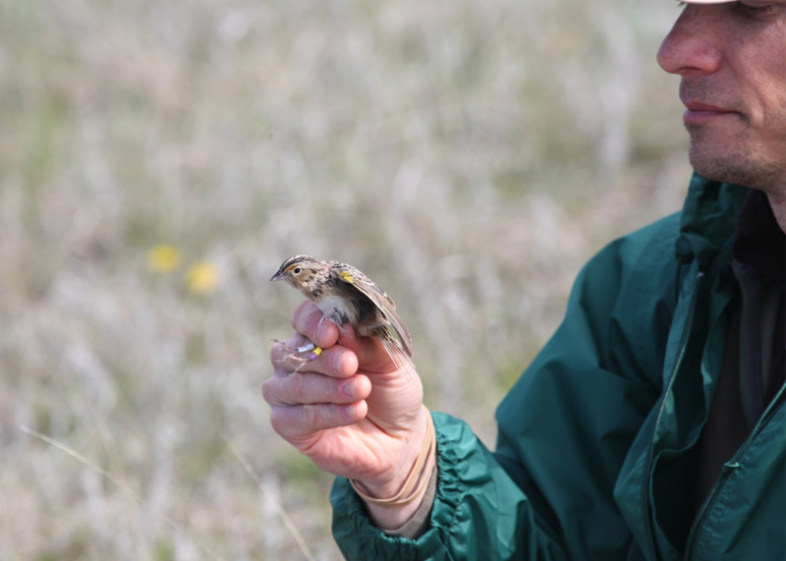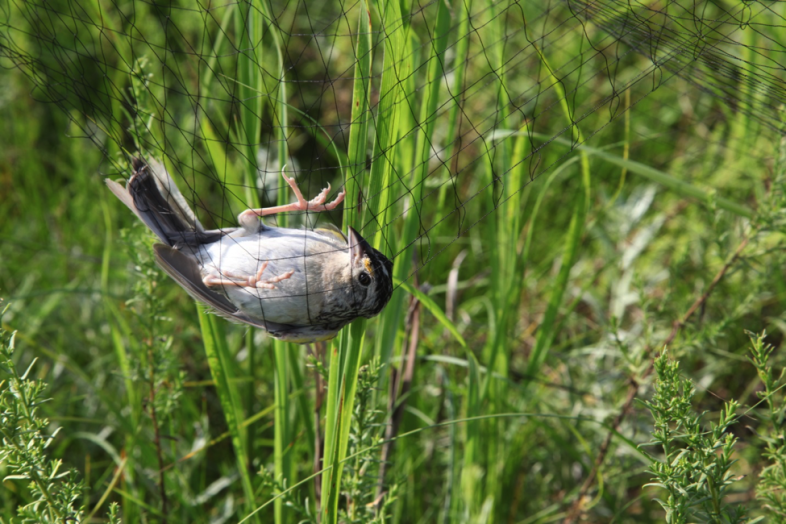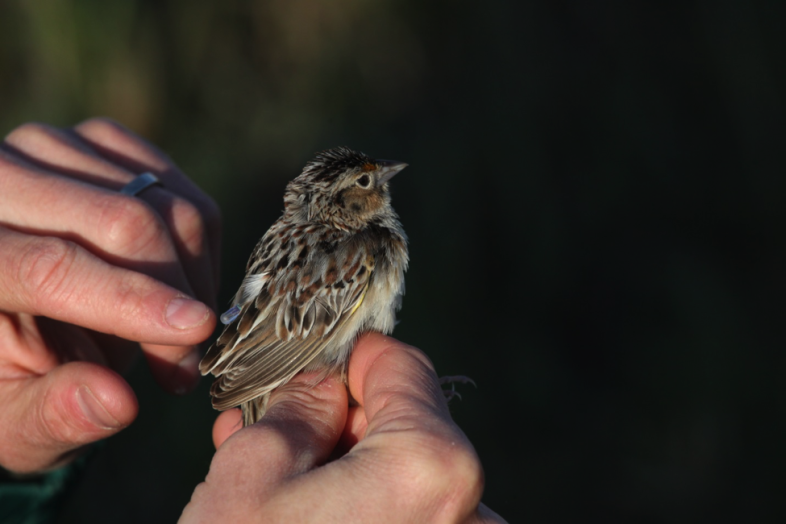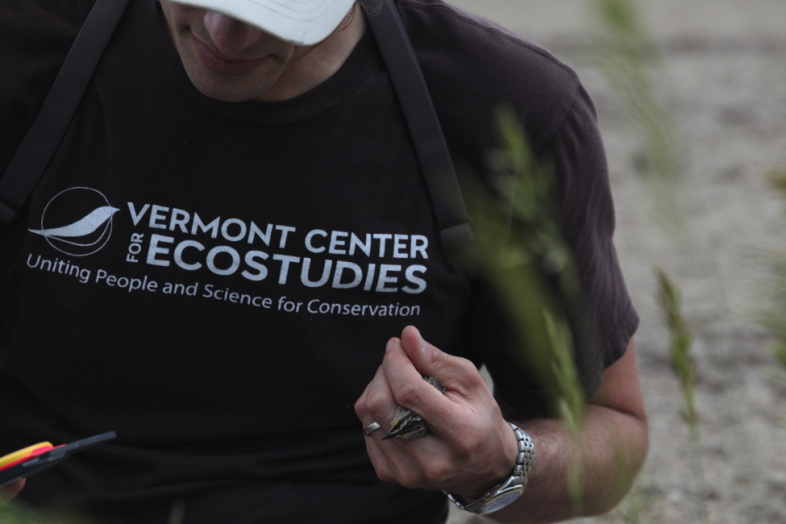
Jason Hill prepares to release a color-banded male Grasshopper Sparrow wearing a light-level geolocator. “See you next summer!” Photo by Alexandra Lehner.
By mid-June we were pretty used to tanks shooting over us and helicopters buzzing past our heads. Such is a typical day of research on an active military reservation. The Grasshopper Sparrows never seemed to mind as far as we could tell. Some mornings we would arrive early in the dark, just past 5 a.m., and watch tracer ammunition from the flying gunships light up the silhouetted grassland as they fired at invisible (at least to us) manmade targets. Through it all, the Grasshopper Sparrows kept singing, and we kept chasing them.
Over the last two months my crews and I have been capturing male Grasshopper Sparrows at six military installations across the U.S., from Kansas to Maryland, in an attempt to understand several fundamental aspects of their biology: When do they migrate? What route do they take? And where do they spend the winter? Pretty simple questions, really, but ones that have been surprising difficult to answer. How do you follow a 0.5 ounce bird over hundreds of miles and back again? It is always refreshing for me to think that the answers to such questions begin with the simple act of capturing birds in mist nets—something people have been doing for many hundreds of years. Essentially, we lure a male Grasshopper Sparrows into nets by tricking them into thinking that an intruder male has infringed upon his territory.

A male Grasshopper Sparrow hangs out in the net, eyeing us wearily, after being lured into the net by the song of an imaginary intruder. Photo by Alexandra Lehner
My father taught me that storytellers owe their audience a good story, and our research is trying to elucidate an incredible narrative about the movements and population connectedness of multiple Grasshopper Sparrow populations. Do Grasshopper Sparrow populations breeding in Massachusetts and Kansas spend the winter in the same place? Do Grasshopper Sparrows breeding in Minnesota and Wisconsin use the same migration routes and leave their breeding grounds at the same time? Are the processes that limit the number of breeding individuals the same across all of these populations? No one knows the answers to those questions, but after this summer we will be one step closer to understanding their movement behavior.
When we capture a male Grasshopper Sparrow we give him a light-level geolocator, or a really cool souvenir as we like to say. Geolocators are pretty simple technology, they record light levels every few minutes, and they are the only devices that can record location data for nine months and be light enough (pun intended) for a 18-gram sparrow to safely wear. If we can recapture a bird with a geolocator next summer, then we can download that light-level data and estimate when and where that little guy traveled to in the previous year. That’s a pretty great story, or at least I think so.

Male Grasshopper Sparrow at Camp Grafton, North Dakota, wearing a light-level geolocator. Photo by Alexandra Lehner.
Not all of the male Grasshopper Sparrows wearing geolocators will return next year of course. Some of them will succumb to predators and old age, and some of them will simply choose to move to a new grassland beyond our reach. But some of them will return in 2016, and we will be there waiting to lure them into our nets again. And when they do we will take off that geolocator, and download the last nine months of data. And the birds you ask? Well, they will have a pretty good story to tell.
(Read more about our work on Department of Defense installations.)

Jason Hill hills bands and measures a male Grasshopper Sparrow before affixing a light-level geolocator at Fort Riley, Kansas. Photo by Alexandra Lehner

Fascinating questions to be answered and ingenious technological toys to help find the answers. Have not more traditional, simple observational, means been able to determine migration routes and destinations?
Howdy John,
Unfortunately, no. I have color-banded several thousand grassland birds and no other person has ever seen/recaptured/reported one during migration or during winter. It can happen, but the chances are tiny–think needle in a haystack. I see two main challenges to relocating Grasshopper Sparrows (GRSP) through traditional means during migration and winter.
1. Off of the breeding grounds GRSP are rather secretive and non-vocal, occur in low density, and they are hard to see because they spend all of their time on the ground in big grasslands.
2. Their winter range extends across a huge area (Southern US and Central America + some Caribbean Islands), and GRSP occupy grasslands–habitats with very low human density. So it’s unlikely that someone would happen to see one out their window (like at your house in Texas).
If our research identifies some key stop-over and/or over-wintering areas used by Grasshopper Sparrows then targeted observational studies at these locations in the future may provide alternative means to estimating their survival. Please let me know if anyone reports a color-banded GRSP this winter in Texas on the local birding listervs. All the best.